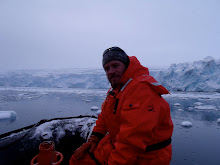
This is Ryan above, telling us about the GPS units we have on station. We use a combination of the GPS's and a lamented map to figure out where we are. I have only been out three or four times so I don't know some of the islands yet, but I suppose if you do this everyday as some do, it would be pretty easy to remember.

This is Malcolm Arnold driving the boat. He is the doctor for the winter. We all take turns driving and learning how to steer and deal with the outboard motor. Depending on how windy it is, it could be very difficult to handle this thing.

Every landing site on every island is clearly marked. Before these are marked people go out and determine the best place to land the boats so as to not damage anything on the island and not interrupt wildlife. These two painted red dots are where we land.

As you can see from this picture, some of the landings can be rather rocky and difficult to land on. I'm glad we didn't try to get out on this island.

In this picture, Ryan is teaching us about tying the boat up. It is a good idea to leave some slack in the line so that the boat is not sitting on the rocks if the tide goes out. There is also an anchor involved.


Every landing site also has a little metal anchor bolted into a rock. You can kind of see it in the close up picture. We have to tie the boat off when we land so that it doesn't blow away. Obviously. Here Ryan is tying a fancy knot. One that I cannot do and cannot pronounce.

As we cast off the island, Ryan pulls up the stern anchor.

These pictures are pretty cool. The last part of the class involved rescuing a man overboard. It is a very frightening thought, to be overboard in the frozen Antarctic waters. But a quick bump or a sharp turn can easily do it. So Jack, bless his heart, volunteered to get in the water. I actually think he was the only one that could because the immersion suit we grabbed was a size small. Thank goodness I'm a fat guy!

It's actually almost too small for Jack to fit into. But he squeezes in.


I really like these two pictures. Just hanging out in Hero Inlet in an immersion suit in Antarctica. Great. Who else gets to do this shit!? It's awesome!! My buddy Capt'n Dave Bardun says that the immersion suit is actually rather comfortable. Yes, we did rescue Jack. I don't have any photos of it cause there were only three of us in the class and I had to do my fair share of pulling Jack out of the water. Ryan had him play unconscious so we would get the feel of a worst-case-scenario scenario. Pulling an unconscious victim out of the water. It's not fun! Even the smaller people are heavy when wet!


And just for fun, here's some candid shots of me that Jack took. The suit I have on is mandatory for water travel. We call them float coats. They are not immersion suits meaning if we fell in the water they would not keep us alive very long. The suit that Jack has on above is an immersion suit. These suits are designed to keep you afloat and alive for an extended period of time if you were to fall in the water or if your boat was to sink. The float coat I have on is insulated so it works great in the environment we are in. It's not a life support system.
So this is a cool thing. We have webcam now! That means the world can look in and see Palmer Station. The link is below. There is a 15 second refresh but you are looking at Palmer live! Check it out! It's pretty cool.
http://www.usap.gov/videoclipsandmaps/palwebcam.cfm
Stay tuned next week (or earlier)for another food blog!!!

No comments:
Post a Comment